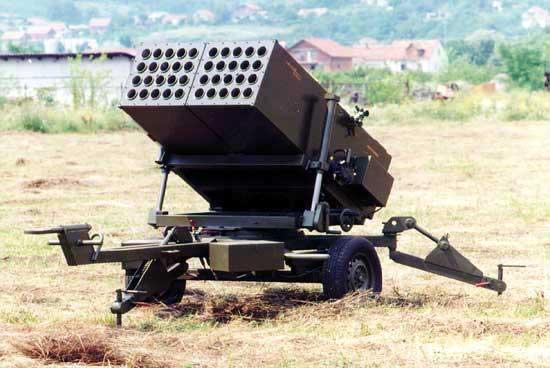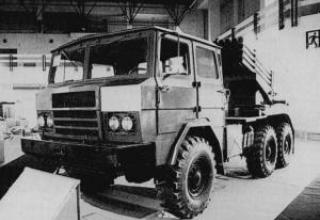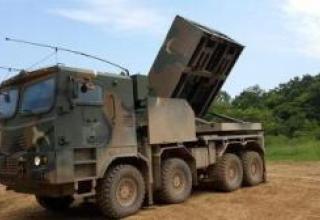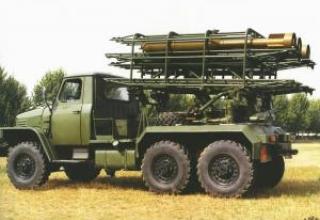The M93A3 Heron 40-bore towed lightweight rocket launcher is designed to fire 70 mm unregulated rockets (NURS).
The M93A3 is an all-weather system with direct and indirect fire capability to support artillery.
It is designed and manufactured by Duro Dakovic Special Vehicles Ltd. (Slavonski Brod, Croatia), a joint stock company of Duro Dakovic Holding Company, and is in service with Croatian Army.
Composition:
The artillery part of the launcher (PU) is mounted on a single axle trailer of cross-country ability (see the side view, at the rear), equipped with UN-2 sights. When equipped, the PU can be towed over rough terrain at speeds of up to 15 km/h.
The launcher provides launch of single projectiles as well as salvo fire from 2 to 40 projectiles in salvo. In salvo fire, it can hit an area target of 200x300 m at ranges of up to 8000 m.
The M93A3 PU has built-in performance testing facilities and is designed on a modular basis, which provides easy access to all units and quick replacement of failed ones.
As one of the advantages of the developers given the possibility of full remote control (probably means the possibility of remote guidance and shooting). It is controlled by remote control from a distance of up to 25 metres.
The main type of ammunition is the 70mm HE70 TF M95, an unguided high-explosive fragmentation projectile with RT M91, RT M95 impact fuses. It is reported that there are variants of NURS with incendiary and smoke-smoking head units in the ammunition set. The projectiles are delivered and transported in a standard capping of 6 pieces (see photo).
Characteristics:
| launcher | |
| Dimensions, mm: - length - width - altitude |
3150 1850 1400 |
| Weight, kg: - with shells - shellless |
1250 920 |
| Maximum time to prepare for firing, mines. | 2 |
| Number of tubular rails, pcs. | 40 |
| Guide length, mm | 1600 |
| Angle of elevation, degree: - minimum - maximum |
–1 +46 |
| Angle of horizontal firing, degree: - to the right of the chassis axle - to the left of the chassis axle |
15 15 |
| НУРС HE 70 TF M95 | |
| The projectile caliber, mm | 70 |
| The length of the projectile without the fuse, mm | 1212 |
| Weight, kg: - shell - fuse head - bursting charge - propellant |
8,77 3,9±0,15 1,45±0,1 1,8 |
| Maximum flight speed, m/s | 440 |
| Maximum flight range, m | 9000 |
| Operating temperature range, ° C | -30 – +50 |
Testing:
The first flight test of the XMG-M52C "Lance" rocket with extended range was conducted at White Sands Range on March 6, 1969. The first series of missiles entered the army for military trials in April 1971. The first launch took place in August 1972, and in March 1972 the military trials were fully completed.
In May 1972, the missile system "Lance" was officially recognized as a protocol model of military equipment and was classified as a class "Standard A". However, only a Lance missile with a nuclear warhead was included in this class, as Congress had not yet approved the development of a cluster bomb head unit, which the command of the ground forces considered necessary to have in service.
Immediately after the approval of the missile, the delivery of the Lance missile system to NATO partners and Israel began. Six divisions were formed in Europe. Two of them were in Germany, which could not but bother the USSR Armed Forces group "Center": the flight time of the Lance missile is only about 200 seconds, so there was no way to quickly detect and shoot down the missile. Missiles equipped with non-nuclear head units were delivered to Israel.
There are reports that the Lance missile system was used by U.S. forces during the war in Afghanistan in the late 70's and early 80's.
In the mid-80s, the Lance missile system was withdrawn from service due to the nuclear arms reduction treaty between the USSR and the United States. Currently, the Lance missile is used as a target for anti-missile testing. There is evidence that it is used in the development of the US national missile defense program.
Sources:
- Lanser_raketa_70_M93A3_engleski.pdf
- www.skyscrapercity.com











